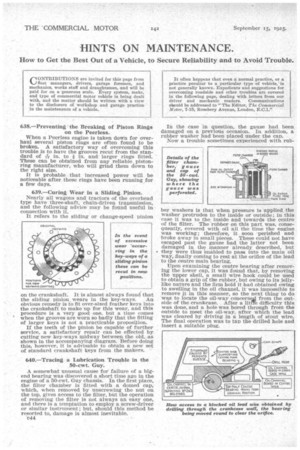- HINTS ON MAINTENANCE.
Page 28

If you've noticed an error in this article please click here to report it so we can fix it.
How to Get the Best Out of a Vehicle, to Secure Reliability and to Avoid Trouble.
638.—Preventing ' the Breaking of Piston Rings on the Peerless.
When a Peerless engine is taken down for overhaul several piston rings are often found to be broken. A satisfactory way of overcoming this trouble is to have the grooves recut from the stan dard of r in, to in. andlarger rings fitted. These can be obtained from any reliable pistonring manufacturer, who will grind them down to the right size.
It is probable that increased power will be noticeable after these rings have been running for a few days.
639.—Curing Wear in a Sliding Pinion.
Nearly all wagons and tractors of the overhead type have three-shaft, chain-driven transmission, and the following advice may be found useful in connection with it. • It refers to the sliding or change-speed pinion on the crankshaft. It is almost always found that
the sliding pinion_ wears in the key-ways. An obvious remedy is to fit over-sized feather keys into the crankshaft to make up for this wear, and this procedure is a very good one, but a time comes when the grooves are worn so badly that the fitting of larger keys is not a practicable proposition.
If the teeth of the pinion be capable of further service, a satisfactory repair can be effected by cutting new ,key-ways midway between the old, as shown in the accompanying diagram. Before doing this, however, it is advisable to obtain a new set of standard crankshaft keys from the makers.
640.—Tracing a Lubrication Trouble in the 50-cwt. Guy.
A somewhat unusual cause for' failure of a bigend bearing was discovered a short time ago in the engine of a 50-cwt. Guy chassis. In the first place, the filter chamber is fitted with a domed cap, which, when removed by unscrewing the nut on the top, gives access to the filter, but the operation of removing the filter is not always an easy one, and there is a temptation to employ a screw-driver or similar instrument ; but, should this method be resorted to, damage is almost inevitable.
b44
In the ease in question, the gauze had been damaged on a previous occasion. In addition, a rubber washer had been placed under the cap.
Now a trouble sometimes experienced with rub
her washers is that when pressure is applied the washer protrudes to the inside or outside ; in this case it was to the inside and towards the centre of the filter. The rubber on this part was, consequently, covered with oil all the time the engine was working; therefore, it soon perished and broke away in small pieces. These could not have escaped past the gauze had the latter not been damaged in the manner already described, but
• they were thus 'enabled to pass into the main oil way,-Enally coming to rest at the orifice of the lead to the centre main bearing.
Upon examining the centre bearing after removing the lower cap. it was found that, by removing the upper shell, a small wire hook could be used to obtain a grip of the rubber, but owing to its jellylike nature and the firm hold it had obtained owing to swelling in the oil channel, it was impossible to remove it in this manner, so the next thing to do was to locate the oil-way coneerneg from the outside of the crankcase. After a litM difficulty this was done, and a hole was bored through from the outside to meet the oil-way, after which the lead was cleared by driving in a length of stout wire. The final operation was to tap the drilled hole and insert a suitable ping.






























